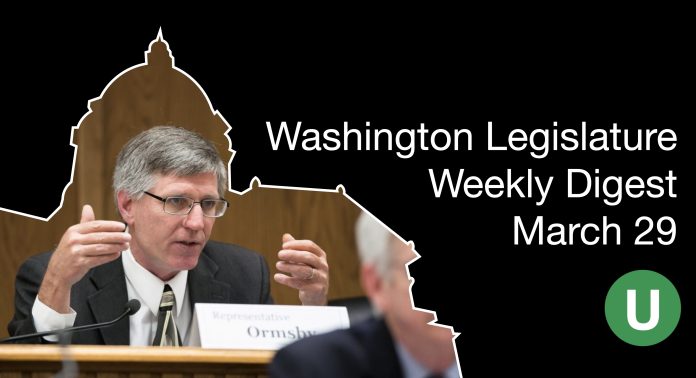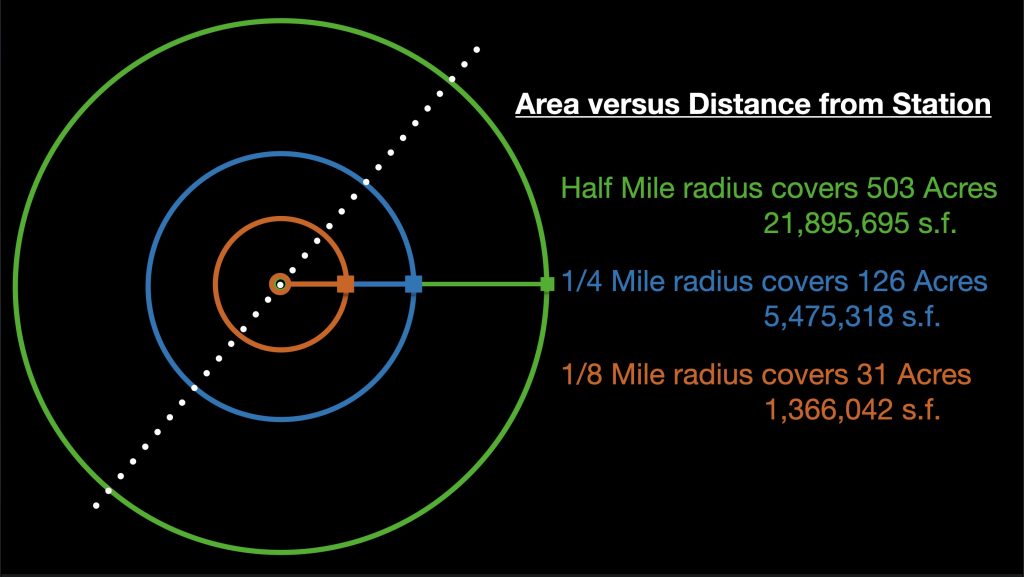
WALeg Wednesday considers bill shrinkage and more legislative budget proposals fill in the state financial picture.
- In This Digest:
- Striker Amendments Threaten 75% to 94% of TOD
- Important Bills At A Glance
- Weekly Focus: Washington’s Operating Budget Starts to Take Shape
Striker amendments threaten 75% to 94% of potential TOD.
Several striker amendments were introduced to rewrite the HB 1110 Missing Middle bill and the SB 5466 Transit Oriented Development bill as they moved through committees this week. Both of the bills look to increase density near frequent transit stations, and define “near” as a circle drawn from the location of the station. Early drafts set this distance at a half-mile, but amendments have attempted to winnow that to one-quarter mile or one-eighth. The proposed amendments reduce their areas of impact by cutting the distance the law applies around a station.
This is a bigger impact than it first appears, and to show why, we will do a little math. Area is length times width. So look at your nearest tile floor, and start counting squares. If you take one tile edge wide and another tile edge wide, you get an area of…wait for it… one tile. Two tile edges wide and two high — doubling the edges — turns into four tiles. Doubling it again — four tile edges on a side — quadruples the number to 16 tiles. Same applies to circles (with that mysterious pi thrown in). Doubling the radius quadruples the area. It’s the reason why a 9-inch pizza is a personal pan, an 18-inch pizza is an XL-family sized, and a 36-inch pizza is a dare.
If doubling the sides quadruples the area, the same is true in reverse. Halving the distance quarters the area. So the simple act of decreasing the area of effect from a half-mile to a quarter-mile doesn’t just half the number of homes possible, it removes an eye watering 75% of the possible developable area. Then there is another 75% reduction when the area of impact is again halved to one-eighth of a mile, as some amendments do. An eighth-mile area is 94% smaller than a half-mile area.

The concern that many are having is that these changes in distance sound small, but the impacts are significant. Reducing the area affected by these bills by 75% or 95% guts the purpose of expanding affordable, walkable housing. When one takes into account streets and the stations themselves, 31 acres really whittles down to a couple of additional units. Not the density that can really hit a tipping point to bring services and amenities into a walkable area.
For context, Green Lake (including the lake) and Woodland Park together are about 500 acres. Just Woodland Park is about 100 acres. And Woodland Park Zoo, without many of the parking lots, is around 30 acres. An argument could be made that a half-mile circle is too big because 500 acres exceeds the size of several municipalities in the Seattle area, specifically Yarrow Point, Hunts Point, and Beaux Arts Village. A counter argument is that there is no reason for jurisdictions of that size with zoning authority to exist within a Growth Management Area (GMA) during a climate and housing crisis.
Important Bills At A Glance.
- HB 1110 – Missing Middle Housing – Increasing middle housing in areas traditionally dedicated to single-family detached housing.
- Next Move – The Senate Committee on Housing passed with amendments. Sent to Ways and Means.
- March 31 – Scheduled for public hearing in Ways and Means at 12:30pm.
- Notes – New amendments in the Senate made changes including sucking in the area required to permit missing middle around transit stops to one-quarter mile instead of one-half mile, and exempting areas around 100,000+ square foot shopping centers.
These are on top of the amendments, noted previously, the bill gained while passing the House with a striker amendment. - More Coverage – Read about the earlier amendments it took to get out of committee and PSRC’s analysis of the number of potential homes original versions bill would create.
- HB 1181 – GMA Climate Change provisions – Incorporating climate change provisions in municipal and county comprehensive planning.
- Next Move – Passed out of the Senate Committee on Local Government, Land Use and Tribal Affairs on March 16. Referred to Ways and Means for a public meeting on March 23. No action since.
- More Coverage – Please see December’s Meetup with Futurewise and Futurewise’s campaign page.
- SB 5466 – Promoting Transit Oriented Development – Permitting increased density in specified areas around high frequency transit.
- Next Move – Mar 28 – Executive action taken in the House Committee on Housing at 4pm.
- Mar 30 – Scheduled for public hearing in the House Committee on Capital Budget at 9am in anticipation of other legislative action.
- Mar 31 – Scheduled for executive session in the House Committee on Capital Budget at 9am in anticipation of other legislative action.
- Notes – A proposed striker amendment guts a number of provisions of the bill, including reducing the area around stations to 1/4-mile around frequent transit, and 1/8-mile around bus routes. The 1/8-mile appeared then disappeared from the House bill.
- More Coverage – The Urbanist did a big breakdown of the bill from January and also has done a little coverage of transit-oriented development (TOD) in the past. Sightline Institute also has some good info on this TOD bill.
- HB 1245 – Lot Splitting – Requiring jurisdictions to allow recorded properties to be divided for additional buildable lots.
- Next Move – Executive session of the Senate Committee on Local Government, Land Use and Tribal Affairs on March 28 took no action on the bill.
- More Coverage – See the March 1 WALeg Weekly Focus for more information about the bill.
- Notes – Floor amendment by Rep. Andrew Barkis (R – LD2 Yelm, Eatonville), who is doing some interesting housing work this year, increased resulting lots to minimum 2,000 square feet and effective date to six months after a city’s comp plan update.
- HB 1337 – Easing Barriers for ADUs – Reduces regulatory and construction barriers for the construction of accessory dwelling units.
- Next Move – After a March 16 public hearing in the Senate Committee on Local Government, Land Use & Tribal Affairs, the committee passed the bill at an executive session on March 28. It is now in the Senate’s Rules Committee for a second reading.
- More Coverage – See the March 1 WALeg Weekly Focus for more information about the bill.
- Notes – Striker amendment inserted language about Urban Growth Area compliance and coordination by the Department of Commerce.
- SB 5200 – The Capital Budget
- Companion Bill – HB 1147
- Next Move – The Senate passed an amended bill on March 24. See below for details.
- More Coverage – The extensive list of proposals in the Capital Budget can be looked at in the Proposed Substitute Senate Bill (PSSB) 5200. We covered a little about the process in the Week 11 WALeg Roundup.
- SB 5187 – The Operating Budget
- Companion Bill – HB 1140
- Next Move – After a public hearing on March 24, the Senate Committee on Ways & Means passed the bill in Executive Session on March 27. The bill is currently in the Rules Committee waiting to be placed on the floor calendar.
- More Coverage – More about the current budget below. We covered a little about the process in the Week 11 WALeg Roundup.
Weekly Focus: Operating and Transportation Complete Budget Picture
On Monday, Democrats in Washington’s House of Representatives released their operating budget plan that they’ve titled “Resilient Washington.” This comes on the heels of the Senate Democrats releasing their budget last week. Now, the legislators begin the painstaking process of horse trading with Governor Jay Inslee, and his budget priorities set out back in December. The budgets are a billion dollars apart, with the House’s $69.5 proposal falling between the Senate’s $69.2 billion and the governor’s $70.3 billion.
The House Dems headlined their budget release hitting on topics like education, housing, and public health. “This budget reflects the values of our House Democratic Caucus and what we have heard from the people of Washington. It is a $69.5 billion biennial budget that is both responsible and sustainable,” said Rep. Timm Ormsby (D-Spokane), chair of the Appropriations Committee in a statement announcing the budget release.
The biggest single numbers were attached to three salary boosting items: $570 million for teacher salaries, $344 million for behavioral health providers, and $762 million to increase worker rates for individual homecare providers. The amounts reflect the double sides of underpaid workers in education and health care, as well as the increasing bite that inflation has taken from paychecks.
The operating budget also makes climate investments, including $316 million to continue Climate Commitment Act spending. “Washington has led the nation in fighting climate change. Our passage of the Climate Commitment Act was a prime example of this leadership, and with this budget we arrive at a new milestone on our path to a clean energy future. We’re also investing in natural resource protection and projects to protect our environment for future generations,” said Joe Fitzgibbon (D – West Seattle). Some of the CCA line items include clean energy siting and permitting and local government planning, as well as grants for green house gas reductions, environmental health, and improving air quality in overburdened communities.
Today, the Senate also released its transportation budget for the next two years. Coming in at $12.9 billion dollars, the transportation budget funds transportation projects and the operations of transit related agencies. The announcement did touch on the ongoing road safety crisis, as transportation committee chair Senator Mirko Liias (D-Everett) pointed out. “Traffic safety deaths are even more tragic because they are preventable,” Liias said. “It is unacceptable for our state to continue to see an increase in this trend, and my hope and belief is that with the steps we’re taking in this budget, and with the policies we’re working on this year, we can begin to make our roads safer for bicyclists, pedestrians and motorists.”
Being a transportation budget, the lion’s share of funds are pointed at highway expansion, including the Columbia River Bridge and Puget Sound Gateway. It is noted that a bill to expand the bonding capacity of Connect Washington was also introduced as part of the transportation package. Connect Washington is the $16.1 billion plan from 2015 to expand highways like SR 509, SR 520, I-5 at JBLM and I-405 from Lynnwood to Tukwila.
With operating, capital, and transportation budget proposals now clicking into place, the bulk of the hard negotiations during this 105 day legislative session seem to have passed. Now it is just fine tuning. Unfortunately, many of those early negotiations wiped out a number of promising bills, or as mentioned above, threaten to gut them deeply. It would be interesting to consider how many of these highway expansions would be necessary moving forward had the legislature seized the full opportunity of TOD and missing middle development.
Ray Dubicki is a stay-at-home dad and parent-on-call for taking care of general school and neighborhood tasks around Ballard. This lets him see how urbanism works (or doesn’t) during the hours most people are locked in their office. He is an attorney and urbanist by training, with soup-to-nuts planning experience from code enforcement to university development to writing zoning ordinances. He enjoys using PowerPoint, but only because it’s no longer a weekly obligation.

